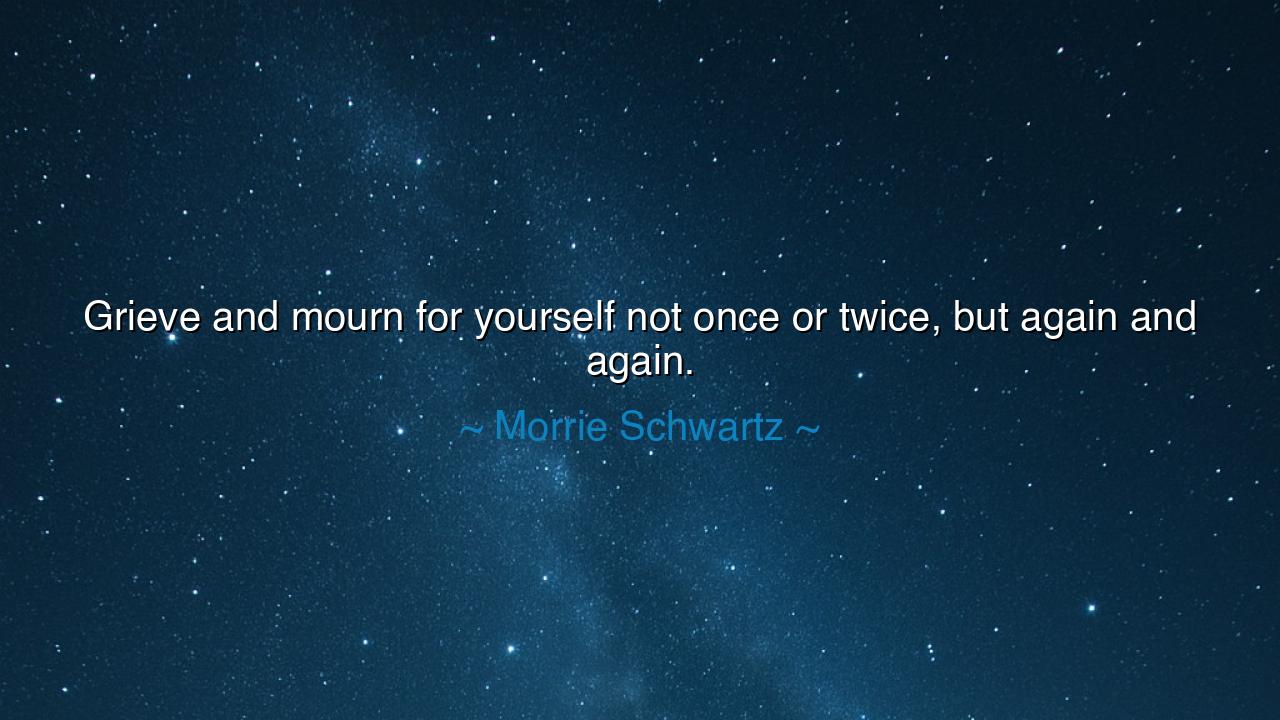
Grieve and mourn for yourself not once or twice, but again and






Morrie Schwartz, the gentle teacher whose wisdom echoed through Tuesdays with Morrie, once gave this tender instruction: “Grieve and mourn for yourself not once or twice, but again and again.” At first hearing, his words may seem strange, for who willingly calls themselves to sorrow? Yet within them is a deep recognition of the human condition: that to face mortality, to face loss, to face decline, one must allow grief to come not as a single flood, but as a tide that returns again and again, until the soul has learned to live with its rhythm.
The ancients, too, spoke of this practice. In the rituals of many peoples, mourning was not confined to a single day. The Jews sat shiva for seven days; the Greeks returned year by year to graves with offerings; the Romans wore black and marked long seasons of mourning. They understood that grief is not a wound healed by one touch of time, but a companion who visits repeatedly, each time loosening the burden a little more. Morrie, in his simple words, gives the same wisdom: to mourn is not to fall into despair, but to honor life by acknowledging its impermanence.
Consider the story of Franklin D. Roosevelt, who was struck by polio and confined to a wheelchair for the rest of his life. Surely he grieved for the loss of his body’s strength, not once but many times over the years. Yet in returning again and again to that grief, he learned not to be broken by it, but to draw out of it compassion, patience, and courage. His repeated mourning became the soil out of which grew his leadership through the darkest days of the Depression and the Second World War. Had he tried to deny or suppress his grief, it might have poisoned him; instead, by embracing it, he was transformed.
Morrie’s wisdom strikes against the pride of those who imagine mourning is weakness. Many think, “I wept once, now I must be strong.” But true strength is not in silencing sorrow, but in allowing it to return when it will, in giving it space to move through the heart. Just as the ocean’s waves return endlessly, so grief comes in cycles. To let it wash over us is to be cleansed. To resist it is to be battered. The wise, like Morrie, welcome grief again and again, and in doing so find peace.
Yet this teaching is not only about death. It speaks also of the many small losses of life — lost youth, lost dreams, lost capacities. Each season of change brings its own mourning. To deny this is to harden the heart, but to embrace it is to grow. When one chapter closes, let there be sorrow; but let that sorrow prepare the way for gratitude, for renewal, for the opening of a new path. This is the eternal dance of mourning and living, loss and renewal.
The lesson, then, is clear: do not imagine that grief is to be finished once and for all. Let yourself mourn again and again, each time loosening the tight grip of fear, each time remembering more tenderly what has been lost, and each time making more room for love. Practical action flows from this: when sorrow rises, do not push it down. Take time to sit with it, to name it, to honor it. Weep, write, speak, or pray. And when it returns later, do not despise it, but greet it as a familiar guest, knowing it comes not to harm you, but to heal you more deeply.
So remember, O children of tomorrow: grief is not the enemy, but the teacher. To grieve and mourn for yourself not once or twice, but again and again, is to accept the truth of being human — that life is precious because it passes, that love is deep because it can be lost, and that mourning is the price we pay for having lived and loved at all. Let your mourning be honest, let it return as it will, and through it you will discover not despair, but the profound strength of one who has faced sorrow fully and yet chosen still to live.






AAdministratorAdministrator
Welcome, honored guests. Please leave a comment, we will respond soon